Embark on a culinary adventure with this incredible Roasted Tomatillo Salsa Verde – a vibrant, flavorful, and remarkably easy-to-make condiment that will revolutionize your Mexican-inspired dishes. Forget bland, store-bought jars; this homemade green salsa boasts a depth of flavor that is simply unparalleled. It’s not just a delight for your taste buds, but also a smart choice for your health, being naturally low in calories and carbohydrates, and packed with beneficial antioxidants. This fresh, zesty salsa is wonderfully versatile, serving as a tantalizing vegan appetizer when paired with crispy tortilla chips, or elevating your favorite enchilada recipes with its bright, tangy kick. Prepare to be amazed by how such simple ingredients can transform into a truly extraordinary salsa.
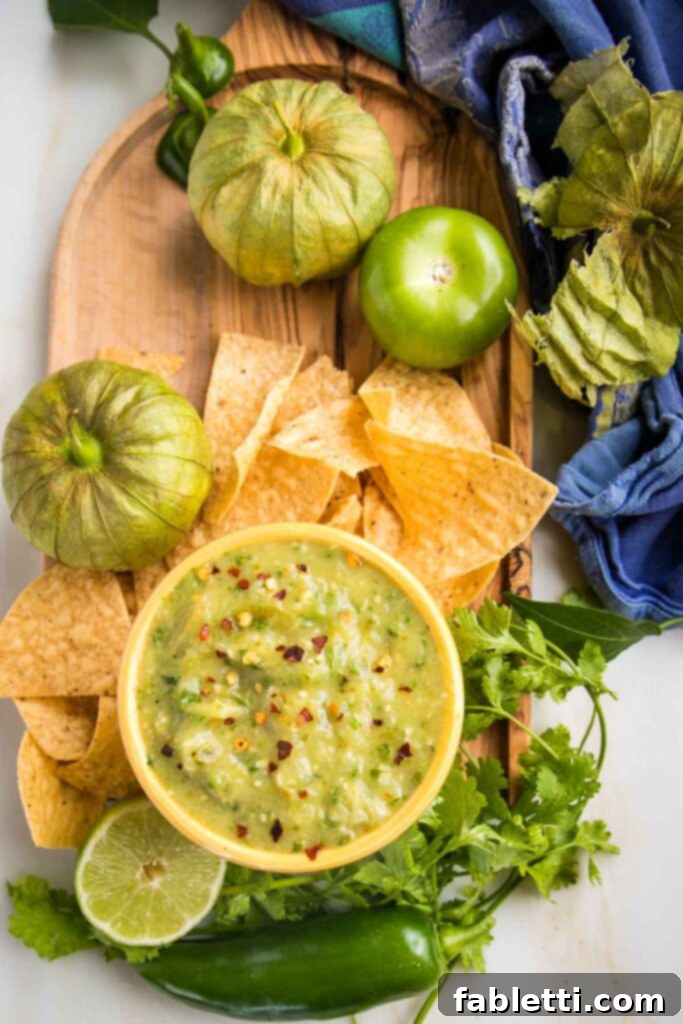
This post has been meticulously updated from its original publication on August 26, 2015, to provide you with the most comprehensive and delicious guide to crafting the perfect roasted tomatillo salsa. We’ve refined our techniques, added more insights, and ensured every detail helps you achieve salsa perfection.
There is genuinely no comparison between the bright, complex flavors of homemade roasted tomatillo salsa verde and the often flat, acidic notes of its store-bought counterparts. The secret lies in using fresh tomatillos, which are readily available at your local farmer’s market or preferred grocery store from early summer through fall. These small, green gems are a nutritional powerhouse, offering a rich source of antioxidants while remaining impressively low in calories and carbs. Their unique tartness mellows beautifully when roasted, creating a savory foundation for the most delicious fresh salsa imaginable.
My only regret is that tomatillos grace us with their presence for a limited season! As the colder months approach and I eagerly await the next summer harvest, I rely heavily on my freezer stash. This ensures I can enjoy the incredible taste of this homemade tomatillo salsa verde all year round. Further down, you’ll find detailed instructions on how to perfectly freeze this recipe, so you can extend the joy of fresh salsa long past the growing season.
The magic truly happens when you roast fresh tomatillos alongside pungent jalapeño peppers, sweet onions, and aromatic garlic cloves. This simple yet transformative step caramelizes their natural sugars, intensifying their inherent flavors and adding a smoky depth that can’t be achieved any other way. You will undoubtedly fall in love with this roasted tomatillo salsa recipe. It’s not only incredibly easy to prepare but also offers a refreshing and delightful change from traditional tomato-based salsas, inviting you to explore new dimensions of Mexican cuisine.
Key Ingredients and Smart Substitutions for Perfect Salsa Verde
Crafting the perfect roasted tomatillo salsa involves selecting the right ingredients and understanding how each contributes to the overall flavor profile. While the core components are simple, subtle variations can profoundly impact the final taste. Here’s a detailed look at what you’ll need and how you can adapt the recipe to suit your preferences.
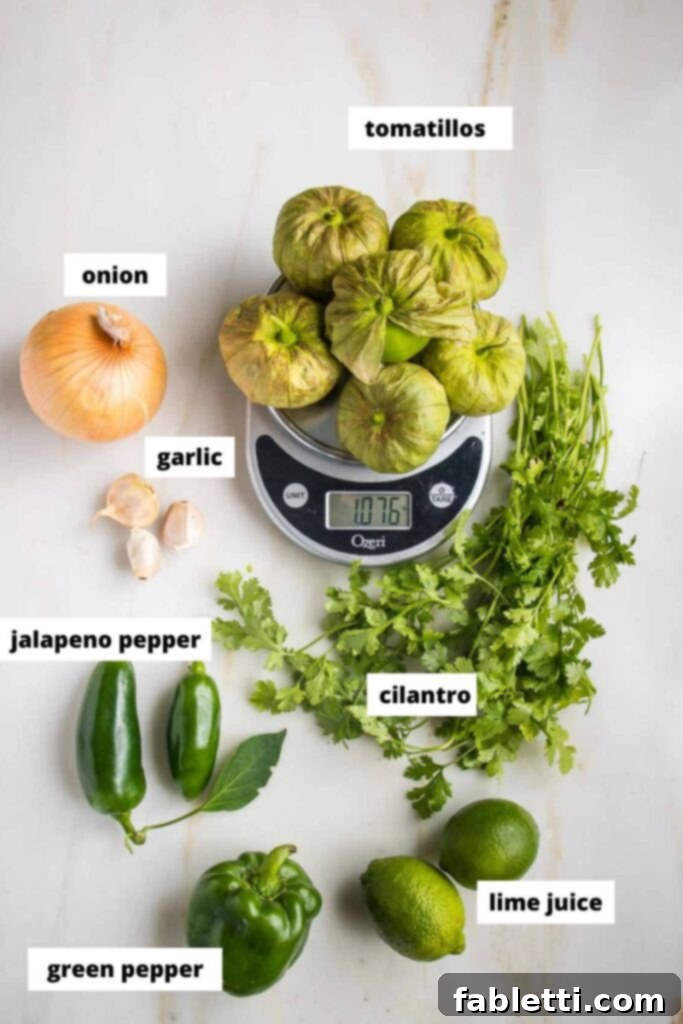
- Tomatillos: These are the star of our salsa verde. Raw tomatillos possess a distinctly acidic and slightly tart flavor, which some find a bit intense. Roasting them before blending is a crucial step that not only mellows this acidity into a more savory, complex taste but also makes the salsa significantly easier to digest and more palatable. It’s important to distinguish tomatillos from small green tomatoes (unripe tomatoes); while both are green, they are botanically different and offer distinct flavor profiles. Using green tomatoes would result in a completely different kind of salsa altogether. When selecting tomatillos, look for firm, vibrant green fruit with tight-fitting husks.
- Jalapeño Peppers: Jalapeños provide a moderate level of heat, but their primary contribution to this salsa is their fresh, green pepper flavor. For those who crave a spicier salsa, feel free to substitute with serrano chiles or even habaneros, but be mindful of their increased potency. If you prefer a milder, more earthy flavor with less heat, poblano peppers are a delicious alternative that will still contribute a wonderful depth to the recipe. Remember, you can always control the heat by removing the seeds and membranes, where most of the capsaicin resides.
- Onion: Raw onion can be quite pungent and may cause heartburn for some individuals. By roasting the onion alongside the tomatillos, its sharp edges are softened, transforming into a sweet, caramelized essence that beautifully complements the other roasted vegetables. If you’re short on time or prefer a different flavor, scallions (green onions), red onion, or even fresh chives can be used, though their flavor will be brighter and less mellow than roasted white onion.
- Garlic: Roasting garlic is a game-changer. It transmutes the raw clove’s sharp, biting flavor into a wonderfully sweet, creamy, and deeply aromatic paste. This process makes it far more agreeable to both your taste buds and your digestive system compared to using raw garlic, which can sometimes overpower the delicate balance of a salsa.
- Fresh Cilantro: The addition of fresh herbs, particularly cilantro, makes an immense difference in the vibrancy and authenticity of your favorite salsa recipes. Its bright, citrusy notes are quintessential to Mexican cuisine. However, if you’re among those who find cilantro to have a “soapy” taste, don’t despair! Fresh oregano or flat-leaf parsley can serve as excellent substitutes, providing a different but equally delightful herbaceous quality.
- Green Pepper: Incorporating a small amount of raw green pepper into the blended salsa adds a fresh, crisp texture and a vital burst of Vitamin C, which remains intact since it’s not exposed to heat. It provides a counterpoint to the roasted flavors, brightening the salsa’s overall profile.
- Lime: Fresh lime juice is indispensable. Its tart acidity perfectly balances the savory, roasted flavors, providing a crucial zing that awakens the palate. Furthermore, the citric acid in lime juice acts as a natural preservative, helping the fresh salsa maintain its vibrant flavor and color for longer.
- Olive Oil (Optional): A light drizzle of olive oil before roasting helps the vegetables caramelize beautifully, contributing to a richer flavor and a smoother texture in the final salsa. It’s an optional but highly recommended addition.
- Sea Salt (Optional): A sprinkle of sea salt before roasting and to taste after blending is essential for enhancing all the natural flavors of the vegetables. It brings everything into harmony, ensuring a well-seasoned and perfectly balanced salsa.
Fascinating Tomatillo Facts
Beyond their role in delicious salsa, tomatillos are truly intriguing fruits with a rich history and unique characteristics. Understanding these facts deepens our appreciation for this humble ingredient.
- Tomatillos (Physalis philadelphica) are small, spherical fruits encased in a distinctive papery husk, resembling miniature lanterns. While they are often treated as vegetables in culinary applications, they are botanically fruits. It’s crucial to reiterate that they are not merely unripe green tomatoes, despite their similar appearance. Tomatillos have a denser texture and a more acidic, citrusy flavor profile compared to tomatoes.
- These versatile fruits can be enjoyed in various ways. When eaten raw, finely chopped into salads, or pureed into a vibrant salsa, they offer a noticeably sour and tart flavor. This characteristic tang is highly prized in certain dishes. However, many culinary traditions prefer to cook tomatillos, as the heat mellows their intense acidity, transforming it into a more complex, savory, and slightly sweet flavor that forms the backbone of many traditional Mexican sauces.
- Their culinary applications extend far beyond salsa verde. Cooked tomatillos excel in roasted salsa verde, where their roasted flavor shines. They are also frequently braised in rich stews, such as pork chile verde, where they contribute a tangy counterpoint to rich meats. Additionally, sautéed tomatillos can be a fantastic addition to stir-fries, various vegetarian dishes, or even as a topping for grilled fish or chicken, showcasing their adaptability in diverse culinary contexts.
Crafting Your Own Roasted Tomatillo Salsa: A Step-by-Step Guide
Making homemade roasted tomatillo salsa is an incredibly rewarding process, yielding a fresh, vibrant, and utterly delicious result. Don’t be intimidated by the idea; it’s simpler than you might think! Follow these steps to create a salsa that will impress everyone.
If this is your first time working with tomatillos, you might be surprised by the slightly sticky or tacky feel underneath their papery husks. This is entirely normal and no cause for alarm; it’s simply a natural resin. That’s precisely why I strongly recommend thoroughly rinsing off this sticky residue with warm water immediately after you remove those papery husks. This ensures a clean base for roasting and blending.
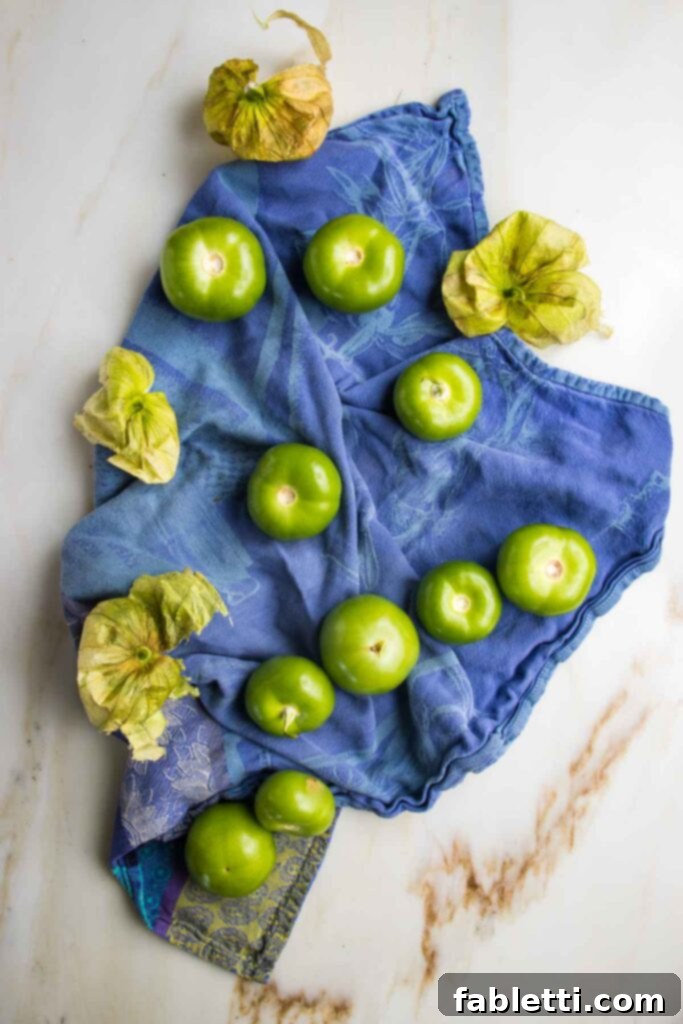
The crucial first step in building the deep flavor of this salsa is to roast the tomatillos along with the onion, garlic, and jalapeños. This process caramelizes their natural sugars, developing a rich, smoky, and irresistible taste that raw salsa simply cannot achieve. To prepare the jalapeño pepper safely and efficiently, cut it in half lengthwise through the stem. Then, use a grapefruit spoon or a small paring knife to scoop out the seeds and the white membranes. These membranes are where the majority of the capsaicin, the compound responsible for heat, is concentrated. If you’re aiming for a spicier salsa verde, consider leaving a few of the seeds and some membrane intact in the jalapeños before roasting them with the other vegetables.
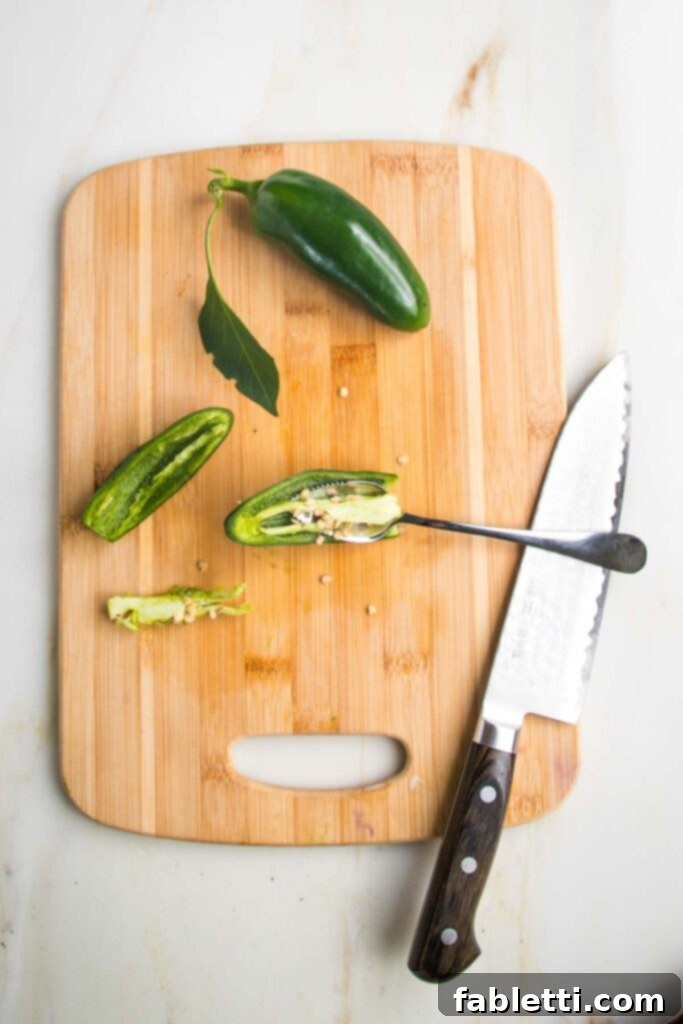
For roasting, opt for a heavy-duty, rimmed baking sheet. Arrange your prepped vegetables—tomatillos, jalapeños, and onion—in a single layer, ensuring they have enough space to roast evenly without steaming. Crucially, leave the papery skins on the garlic cloves; this protects the garlic from burning and allows it to steam-roast within its skin, becoming wonderfully soft and sweet. For an optional but highly recommended enhancement, drizzle the vegetables lightly with olive oil and sprinkle generously with sea salt. This aids in caramelization and seasons the vegetables from the start. Roast them in a preheated 450°F (232°C) oven for approximately 15 minutes, or until the tomatillos are soft and slightly charred, and the onions and jalapeños show signs of tender, sweet caramelization.


Once roasted to perfection, carefully scoop all the softened vegetables, including any delicious juices that have accumulated on the baking sheet, into the bowl of a food processor. A blender would also work perfectly if that’s what you have on hand, though a food processor often provides more control over texture. The skins on the roasted garlic cloves will now be loose and easy to remove; simply peel them off, or you can squeeze the softened garlic pulp directly out of the skins and discard the empty husks. Process the roasted vegetables until they reach a creamy, uniform consistency, stopping to scrape down the sides of the bowl as needed.
Next, it’s time to add the fresh elements that will brighten and complete your salsa. Add the cored and seeded green pepper, the vibrant fresh cilantro leaves, and the freshly squeezed lime juice to the food processor. Process again until everything is well incorporated and the green pepper is finely chopped. Now comes the most important part: taste for seasoning. This is your chance to customize the salsa to your exact preference. For a more fiery salsa verde, stir in some crushed red pepper flakes or a tiny pinch of cayenne pepper. If you desire a more pronounced tang, add another splash of lime juice. And a pinch of sea salt can work wonders, bringing out all the fresh veggie flavors and ensuring a perfectly balanced taste.
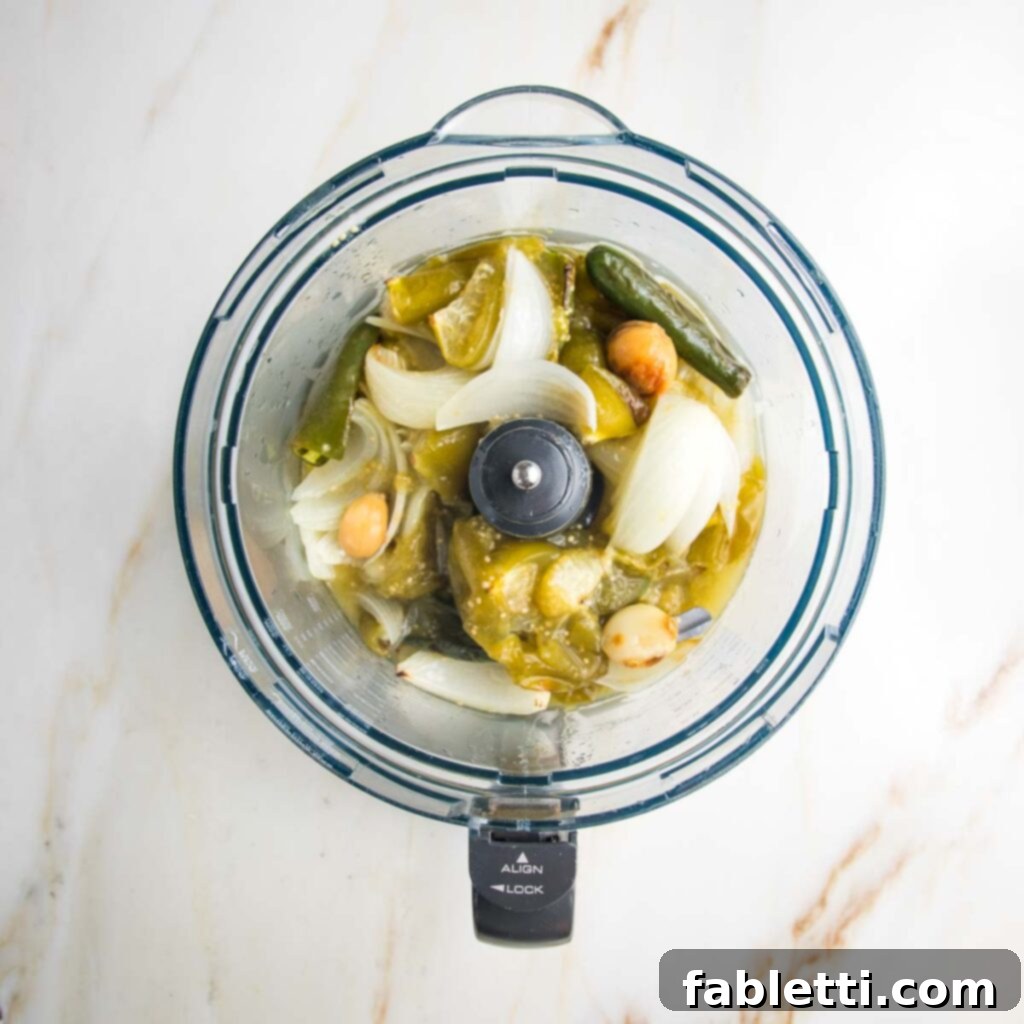


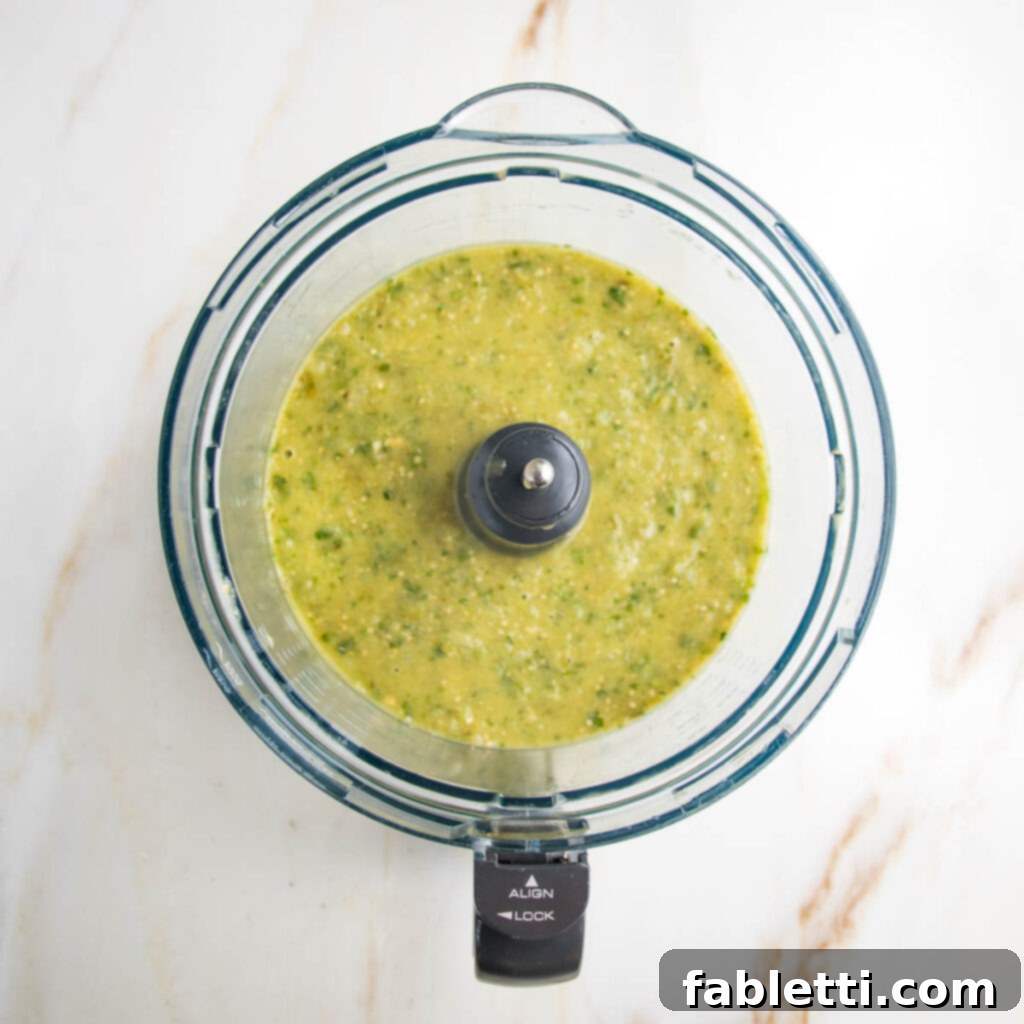
Your homemade roasted tomatillo salsa tastes absolutely divine when served at room temperature, allowing all its complex flavors to truly shine. For an extra touch of visual appeal and a gentle whisper of heat, sprinkle a pinch of crushed red pepper flakes over the top just before serving. Gather your favorite crispy tortilla chips, and get ready to enjoy a truly authentic and deeply satisfying salsa experience that will transport your taste buds straight to Mexico.

Debra’s Expert Pro Tips for Ultimate Salsa Success
Elevate your roasted tomatillo salsa game with these tried-and-true tips, designed to maximize flavor, versatility, and convenience. From clever meal ideas to smart prep shortcuts, these insights will help you get the most out of your homemade salsa verde.

- Beyond Chips: Creative Uses for Your Salsa: While irresistible with tortilla chips, this salsa is incredibly versatile. Start your day right by making delicious breakfast tacos with some fluffy scrambled tofu, topped with a generous, healthy drizzle of this vibrant tomatillo salsa. It’s also fantastic stirred into grain bowls, spread inside burritos, or spooned over grilled vegetables and meats.
- Don’t Waste the Juices: When transferring your roasted vegetables to the food processor, be sure to scrape every last bit of those flavorful pan juices into the bowl. These juices are liquid gold, contributing immensely to the depth of flavor and helping to achieve that perfect creamy consistency without needing to add extra water, which could dilute the taste.
- A Thoughtful Hostess Gift: Homemade salsa makes a wonderful and personal gift. Pour your freshly made salsa into a charming mason jar, tie a colorful ribbon around the neck, and present it as a delightful hostess gift when you’re invited to a potluck or dinner gathering. It’s a gift from the heart that’s sure to be appreciated.
- Smoky Salsa Variation: For an extra layer of complexity and a smoky flavor, consider adding one or two chipotle peppers in adobo sauce to the food processor along with the roasted vegetables. This will give your salsa a rich, smoky kick that pairs beautifully with the tangy tomatillos.
- Speedy Raw Tomatillo Salsa (When Time is Short): While I absolutely adore the added richness and mellow depth that roasting the tomatillos provides, sometimes you’re truly in a rush! In such instances, a raw tomatillo salsa can be a fantastic alternative. Simply husk, rinse, and roughly chop your tomatillos. Instead of regular onions, use scallions for a milder raw flavor. Combine the chopped tomatillos, scallions, jalapeños (seeded to your preference), green peppers, fresh cilantro, lime juice, and just one clove of raw garlic (to avoid overpowering bitterness) in your blender or food processor. Blend until the desired salsa consistency is achieved, adding a tiny bit of water only if needed to help it blend. It will be brighter and zestier, but still delicious!
- Adjusting Consistency: If your salsa turns out too thick for your liking, you can thin it out by adding a tablespoon or two of water or vegetable broth at a time until it reaches your desired consistency. If it’s too thin, you can gently simmer it on the stove for a few minutes to allow some moisture to evaporate, though this might slightly alter the fresh flavor.
- Spice Level Control: Always taste your chilies before adding them entirely, as heat levels can vary greatly. If you’re unsure, start with less and add more to taste or after blending. Remember, it’s easier to add heat than to take it away!
Meal Prep and Storage Strategies for Your Salsa Verde
One of the many benefits of this roasted tomatillo salsa is how well it lends itself to meal planning and extended storage. Prepare a larger batch and enjoy its fresh flavors throughout the week, or freeze it for months of future enjoyment.
- How to Serve: This versatile salsa is best served at room temperature or chilled, offering a refreshing counterpoint to warm dishes. Use it as a vibrant sauce for nourishing grain bowls, a zesty topping for tacos and enchiladas, a flavorful addition to burritos, or even as a unique dressing for salads. Its bright acidity cuts through richness, making it a perfect complement to many meals.
- Prep Ahead: To make mealtime even easier, you can roast the vegetables a day or two in advance. Once roasted and cooled, store them in an airtight container in the refrigerator. When you’re ready to make the salsa, simply pull out the pre-roasted veggies and proceed with the blending steps. This significantly cuts down on active preparation time.
- Storing Your Salsa: Store the finished roasted tomatillo salsa in a clean, airtight container in the fridge. Thanks to the natural preserving qualities of lime juice and the cooking process, it will maintain its peak freshness and flavor for up to two weeks. The flavors often deepen and meld beautifully after a day or two, so making it ahead can actually enhance its taste.
- Freezing for Long-Term Enjoyment: This roasted tomatillo salsa freezes exceptionally well, allowing you to savor its deliciousness for up to 6 months. For convenient, single-serving portions that are perfect for dipping or adding to individual meals, use one-cup silicone molds. Alternatively, for smaller amounts to easily throw a cube or two into soups, stews, or other recipes for an added burst of flavor, freeze the salsa in Tablespoon ice cube trays. Once frozen solid, transfer the cubes to a freezer-safe bag or container. Thaw in the refrigerator overnight or gently reheat on the stovetop when ready to use.
Explore More Wholesome Mexican-Inspired Recipes
If you’ve enjoyed the vibrant flavors of this Roasted Tomatillo Salsa, you’ll love exploring these other healthy and delicious Mexican-inspired recipes. Perfect for any occasion, from weeknight dinners to festive gatherings, these dishes are packed with flavor and nutritious ingredients.
- Healthy Cinco de Mayo Recipes: A collection of delightful dishes perfect for celebration.
- No Salt Taco Seasoning: Craft your own flavorful taco seasoning without the added sodium.
- Easy Vegan Street Corn: A plant-based twist on a classic street food favorite.
- The Best Guacamole: Creamy, fresh, and perfectly seasoned for dipping.
- Tomato Pico de Gallo: A chunky, fresh tomato salsa that’s bright and zesty.
- Vegan Enchiladas: Comfort food at its finest, packed with plant-based goodness.
- Mexican Cauliflower Rice: A low-carb, flavorful alternative to traditional rice.
- Creamy Vegan Chipotle Dressing: Adds a smoky, zesty kick to any salad or bowl.
- Vegan Taco Soup: A hearty and comforting soup bursting with taco flavors.
Did you know that commenting on and rating recipes is one of the most impactful ways to support your favorite food bloggers? If you had the pleasure of making this roasted tomatillo salsa recipe, please consider leaving a five-star rating below and sharing your thoughts in a comment. We love hearing from you! Additionally, we’d be thrilled if you shared your culinary creations on Instagram by tagging me @dkhealthcoach and using the hashtag #debraklein so we can see your delicious results! Your engagement truly helps our community grow.
📖 Recipe

Roasted Tomatillo Salsa
5 from 2 votes
Rate this Recipe
Pin Recipe
Equipment
- Grapefruit Spoons
- Stainless Steel Heavy Baking Sheet
- Food Processor
Ingredients
- 1 lb. fresh tomatillos (about 6 medium tomatillos)
- 1 sweet white onion
- 1-2 hot green chiles*
- 3 large cloves garlic
- ⅓ cup cilantro leaves
- 1 small green pepper
- 2 limes juiced
- OPTIONAL: 2 Tablespoons olive oil
- OPTIONAL: ½ teaspoon sea salt
Instructions
- Preheat your oven to 450°F (232°C).
- PREP VEGGIES FOR ROASTING: Start by husking the tomatillos, then rinse off any sticky residue thoroughly with warm water. Cut each tomatillo into quarters. Cut the green chiles in half lengthwise, through the stem. Use a grapefruit spoon or a small paring knife to carefully scoop out the seeds and membranes (remove more for less heat, leave some for spicier salsa). Remove the papery skin from the onion, then cut the onion into quarters.
- Place the prepped tomatillos, chiles, and onion onto a rimmed baking sheet. Add the whole garlic cloves, keeping their papery skin on. If desired, drizzle the vegetables lightly with olive oil and sprinkle with sea salt. Toss everything gently to ensure an even coating. Distribute the vegetables in a single layer across the baking sheet to ensure they roast rather than steam. Roast in the preheated oven for approximately 15 minutes, or until the vegetables are tender and slightly caramelized.
- Carefully transfer all the roasted vegetables, along with any accumulated juices from the baking sheet, into the bowl of a food processor. Process until the mixture achieves a uniform, creamy texture.
- Next, prepare the green pepper by stemming and seeding it, then add it to the food processor bowl along with the fresh cilantro and the juice of one lime. Process again until all ingredients are well incorporated and the green pepper is finely chopped. Taste the salsa and adjust the seasoning as needed. You may add crushed red pepper flakes for extra heat, additional salt to enhance flavors, or more lime juice for an extra zing, according to your preference.
- Store your delicious homemade roasted tomatillo salsa in an airtight container in the refrigerator for up to two weeks. The flavors will often deepen and improve over the first day or two.
Notes
Nutrition
Calories: 32kcal
Carbohydrates: 4g
Protein: 1g
Fat: 2g
Polyunsaturated Fat: 2g
Sodium: 67mg
Fiber: 1g
Sugar: 2g
Note
The nutrition calculations were performed using online tools and are estimations. To obtain the most accurate representation of the nutritional information for this or any given recipe, you should calculate the nutritional values with the actual ingredients and brands you used. You are ultimately responsible for ensuring that any nutritional information you rely upon is accurate, complete, and useful for your dietary needs.
Did you make this recipe? Please leave a review below, then snap a picture and tag me @dkhealthcoach or use hashtag #dkhealtcoach on Instagram so I can see it!!
